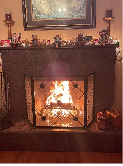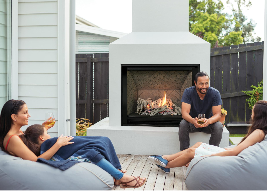Keep your home safe with routine chimney cleanings. Over time, creosote, soot, and debris can build up, increasing the risk of chimney fires and blocking proper airflow. Regular maintenance ensures safe exhaust of smoke and gases as well as helps catch minor issues before they become costly repairs. A clean chimney is a safe chimney - and a smart investment in your home.
Items such as a damper and or glass door can help prevent loss of heat from your home. A high wind directional cap with a spark screen will help prevent downdrafts and improve the draw of the chimney.
Chimney Cleaning & Safety Evaluations
1) Open damper fully
2) Crack a window in close proximity to the fireplace
3) Build the initial kindling fire towards the back wall of the fireplace
4) Be sure to warm the flue; start with good, dried kindling -- we recommend fatwood as a starter (duraflames are ok to help start a fire with wood, but are horrible for creating a good draw in the chimney). Duraflames have higher risk for smoke to come back into the home because they don't burn hot enough to keep a good draw in the chimney.
5) Once it's clear the kindling is allowing the chimney to draw well, slowly add dry, seasoned wood -- it should be light in weight-- if it is heavy and has weight to it, the log is not seasoned and will be difficult to burn, hence creating more smoke that can trickle back into the home.
6) Turn off all mechanical draw appliances - Furnace, kitchen hood, bathroom hood, ceiling fans, etc.
7) Make sure the wood logs have plenty of space / air between them. Fire needs oxygen to breathe. If logs are stacked in a way that doesn't allow air around them, the fire will suffocate, hence smoke will form and trickle back into the room
Let the fire's warmth embrace you,
while you lose yourself in the dancing flames.
Tips for burning wood:



